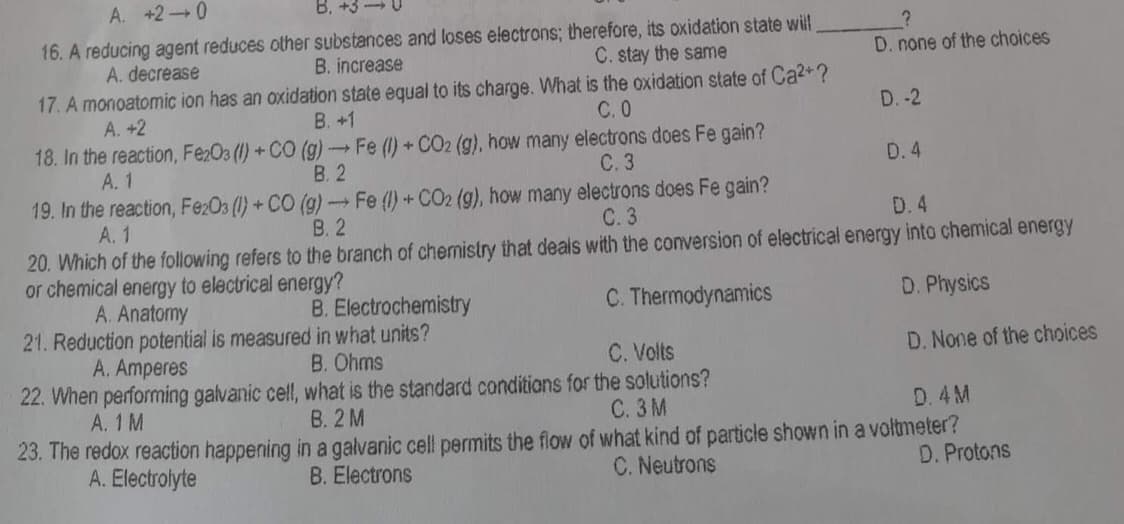A. +2 0 16. A reducing agent reduces other substances and loses electrons; therefore, its oxidation state will A. decrease B. increase C. stay the same D. none of the choices 17. A monoatomic ion has an oxidation state equal to charge. What is the oxidation state of Ca²+? C. 0 A. +2 B. +1 D.-2 18. In the reaction, Fe2O3 (1) + CO (g) → Fe (1) + CO2 (g), how many electrons does Fe gain? A. 1 B. 2 C. 3 D. 4 19. In the reaction, Fe2O3 (1) + CO (g) → Fe (1) + CO2 (g), how many electrons does Fe gain? A. 1 B. 2 C. 3 D. 4 20. Which of the following refers to the branch of chemistry that deals with the conversion of electrical energy into chemical energy or chemical energy to electrical energy? A. Anatomy B. Electrochemistry C. Thermodynamics D. Physics 21. Reduction potential is measured in what units? A. Amperes B. Ohms C. Volts D. None of the choices 22. When performing galvanic cell, what is the standard conditions for the solutions? A. 1 M B. 2 M C. 3M D. 4M 23. The redox reaction happening in a galvanic cell permits the flow of what kind of particle shown in a voltmeter? A. Electrolyte B. Electrons C. Neutrons D. Protons
A. +2 0 16. A reducing agent reduces other substances and loses electrons; therefore, its oxidation state will A. decrease B. increase C. stay the same D. none of the choices 17. A monoatomic ion has an oxidation state equal to charge. What is the oxidation state of Ca²+? C. 0 A. +2 B. +1 D.-2 18. In the reaction, Fe2O3 (1) + CO (g) → Fe (1) + CO2 (g), how many electrons does Fe gain? A. 1 B. 2 C. 3 D. 4 19. In the reaction, Fe2O3 (1) + CO (g) → Fe (1) + CO2 (g), how many electrons does Fe gain? A. 1 B. 2 C. 3 D. 4 20. Which of the following refers to the branch of chemistry that deals with the conversion of electrical energy into chemical energy or chemical energy to electrical energy? A. Anatomy B. Electrochemistry C. Thermodynamics D. Physics 21. Reduction potential is measured in what units? A. Amperes B. Ohms C. Volts D. None of the choices 22. When performing galvanic cell, what is the standard conditions for the solutions? A. 1 M B. 2 M C. 3M D. 4M 23. The redox reaction happening in a galvanic cell permits the flow of what kind of particle shown in a voltmeter? A. Electrolyte B. Electrons C. Neutrons D. Protons
Chapter4: Types Of Chemical Reactions And Solution Stoichiometry
Section: Chapter Questions
Problem 109AE: The blood alcohol (C2H5OH) level can be determined by titrating a sample of blood plasma with an...
Related questions
Question

Transcribed Image Text:A. +2 0
16. A reducing agent reduces other substances and loses electrons; therefore, its oxidation state will
A. decrease
B. increase
C. stay the same
D. none of the choices
17. A monoatomic ion has an oxidation state equal to
charge. What is the oxidation state of Ca²+?
C. 0
A. +2
B. +1
D.-2
18. In the reaction, Fe2O3 (1) +CO (g) → Fe (1) + CO2 (g), how many electrons does Fe gain?
A. 1
B. 2
C. 3
D. 4
19. In the reaction, Fe2O3 (1) + CO (g) → Fe (1) + CO2 (g), how many electrons does Fe gain?
A. 1
B. 2
C. 3
D. 4
20. Which of the following refers to the branch of chemistry that deals with the conversion of electrical energy into chemical energy
or chemical energy to electrical energy?
A. Anatomy
B. Electrochemistry
C. Thermodynamics
D. Physics
21. Reduction potential is measured in what units?
A. Amperes
B. Ohms
C. Volts
D. None of the choices
22. When performing galvanic cell, what is the standard conditions for the solutions?
A. 1 M
B. 2 M
C. 3M
D. 4M
23. The redox reaction happening in a galvanic cell permits the flow of what kind of particle shown in a voltmeter?
A. Electrolyte
B. Electrons
C. Neutrons
D. Protons
Expert Solution
This question has been solved!
Explore an expertly crafted, step-by-step solution for a thorough understanding of key concepts.
Step by step
Solved in 2 steps

Knowledge Booster
Learn more about
Need a deep-dive on the concept behind this application? Look no further. Learn more about this topic, chemistry and related others by exploring similar questions and additional content below.Recommended textbooks for you


Chemistry: The Molecular Science
Chemistry
ISBN:
9781285199047
Author:
John W. Moore, Conrad L. Stanitski
Publisher:
Cengage Learning

Chemistry & Chemical Reactivity
Chemistry
ISBN:
9781337399074
Author:
John C. Kotz, Paul M. Treichel, John Townsend, David Treichel
Publisher:
Cengage Learning


Chemistry: The Molecular Science
Chemistry
ISBN:
9781285199047
Author:
John W. Moore, Conrad L. Stanitski
Publisher:
Cengage Learning

Chemistry & Chemical Reactivity
Chemistry
ISBN:
9781337399074
Author:
John C. Kotz, Paul M. Treichel, John Townsend, David Treichel
Publisher:
Cengage Learning

Chemistry & Chemical Reactivity
Chemistry
ISBN:
9781133949640
Author:
John C. Kotz, Paul M. Treichel, John Townsend, David Treichel
Publisher:
Cengage Learning

General Chemistry - Standalone book (MindTap Cour…
Chemistry
ISBN:
9781305580343
Author:
Steven D. Gammon, Ebbing, Darrell Ebbing, Steven D., Darrell; Gammon, Darrell Ebbing; Steven D. Gammon, Darrell D.; Gammon, Ebbing; Steven D. Gammon; Darrell
Publisher:
Cengage Learning

Chemistry
Chemistry
ISBN:
9781305957404
Author:
Steven S. Zumdahl, Susan A. Zumdahl, Donald J. DeCoste
Publisher:
Cengage Learning